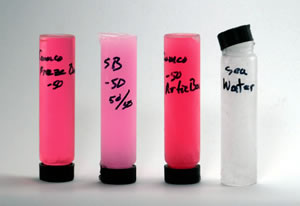
We tested each product for glycol content using a refractometer and either the ethylene glycol or propylene glycol scale, as appropriate. In the case of Camcos Arctic Ban and Sudburys Winter Stor, some portion of the freeze protection is provided by ethanol, and such mixtures cannot be easily evaluated by any field method (test tape, gravity, refractometer) unless the exact proportion is known, which we find troublesome.
Unfortunately, there is no ASTM or generally agreed upon standard test for burst point; we used the same test as many manufacturers using 50-milliliter vials.
To test corrosion protection, we immersed bundles of metal coupons (copper, aluminum, and brass, galvanically coupled) in the antifreeze products, tap water (control), and vodka for two months.
To test chemical compatibility, we reviewed past tests involving toilet joker valves and water system components, and dug into our leftover parts bin for some new tests with ethanol. We examined the parts for cracking and stiffening. None were horrible, but the result will vary according to concentration, temperature, polymer formulation, and winterizing agent formulation.
To test freezing and burst point, the vials were placed in a glycol bath in a freezer set to 0 degrees. At 20 degrees, the vial containing seawater cracked; by 10 degrees, several of the samples began to freeze; and by 0 degrees, all samples had gelled completely, except for Star brite -50, which gelled at -5 degrees. By -10 degrees, all of the samples were solid.
After repeated freeze/thaw cycling at 0 degrees, we pulled a small sample from the top of the duplicate samples and tested freeze point by refractometer. During partial freeze, ice floats, separating the water from the glycol, so the material at the top had lost as much as 7 percent of its glycol content, reducing protection-another reason not to rely too heavily on theoretical burst-point temperatures for determining the right concentration.
We also monitored evaporation at 70 degrees and relative humidity at 65 percent. Only the ethanol-based products were noticeably affected: as a result of evaporation, their freeze point was raised by 2 degrees.
































